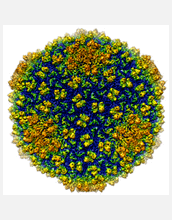Multimedia Gallery
Bacteriophage Epsilon15
Bacteriophage Epsilon15
Shown is an image of bacteriophage Epsilon15, studied by Wen Jiang, assistant professor of biological sciences at Purdue University. The bacteriophage is shown at a resolution of 4.5 angstrom--the highest resolution ever achieved for a living organism of this size. Approximately 1 million angstroms would equal the diameter of a human hair.
Jiang led a research team that included Matthew L. Baker, Joanita Jakana and Wah Chiu from Baylor College of Medicine, and Peter R. Weigele and Jonathan King from MIT, that used the emerging technique of single-particle electron cryomicroscopy to capture the 3-D image of the virus at this resolution.
Knowledge of the details of the structure of a virus can provide valuable information for researchers working on developing disease treatments. If researchers can understand the system--how the virus particles assemble and how they infect a host cell--it will greatly improve their ability to design a treatment. Other methods of determining the structure could not be used for this family of virus. Also, none had been successfully crystallized before, and the complexity of members of this family had prevented evaluation through the genome sequence alone.
This research was funded by the National Institutes of Health and the National Science Foundation (grants IIS 07-05474 and IIS 07-05644). To learn more about this research, see Purdue University news release, "New technique takes a big step in examination of small structures." (Date of Image: September 2007)
Credit: Wen Jiang, Purdue University; Matthew Baker, Joanita Jakata and Wah Chiu, Baylor College of Medicine; Peter Weigele and Jonathan King, MIT
Images and other media in the National Science Foundation Multimedia Gallery are available for use in print and electronic material by NSF employees, members of the media, university staff, teachers and the general public. All media in the gallery are intended for personal, educational and nonprofit/non-commercial use only.
Images credited to the National Science Foundation, a federal agency, are in the public domain. The images were created by employees of the United States Government as part of their official duties or prepared by contractors as "works for hire" for NSF. You may freely use NSF-credited images and, at your discretion, credit NSF with a "Courtesy: National Science Foundation" notation.
Additional information about general usage can be found in Conditions.
Also Available:
Download the high-resolution JPG version of the image. (1.5 MB)
Use your mouse to right-click (Mac users may need to Ctrl-click) the link above and choose the option that will save the file or target to your computer.

